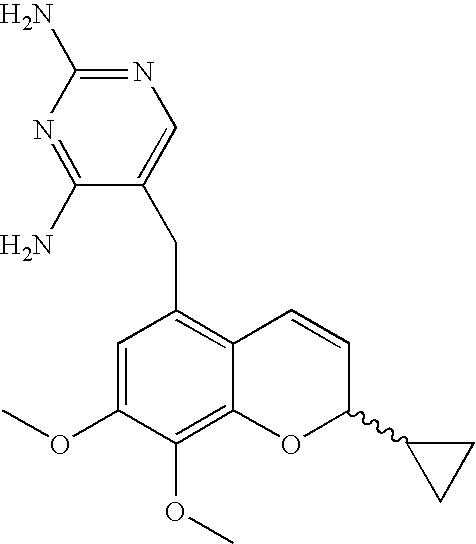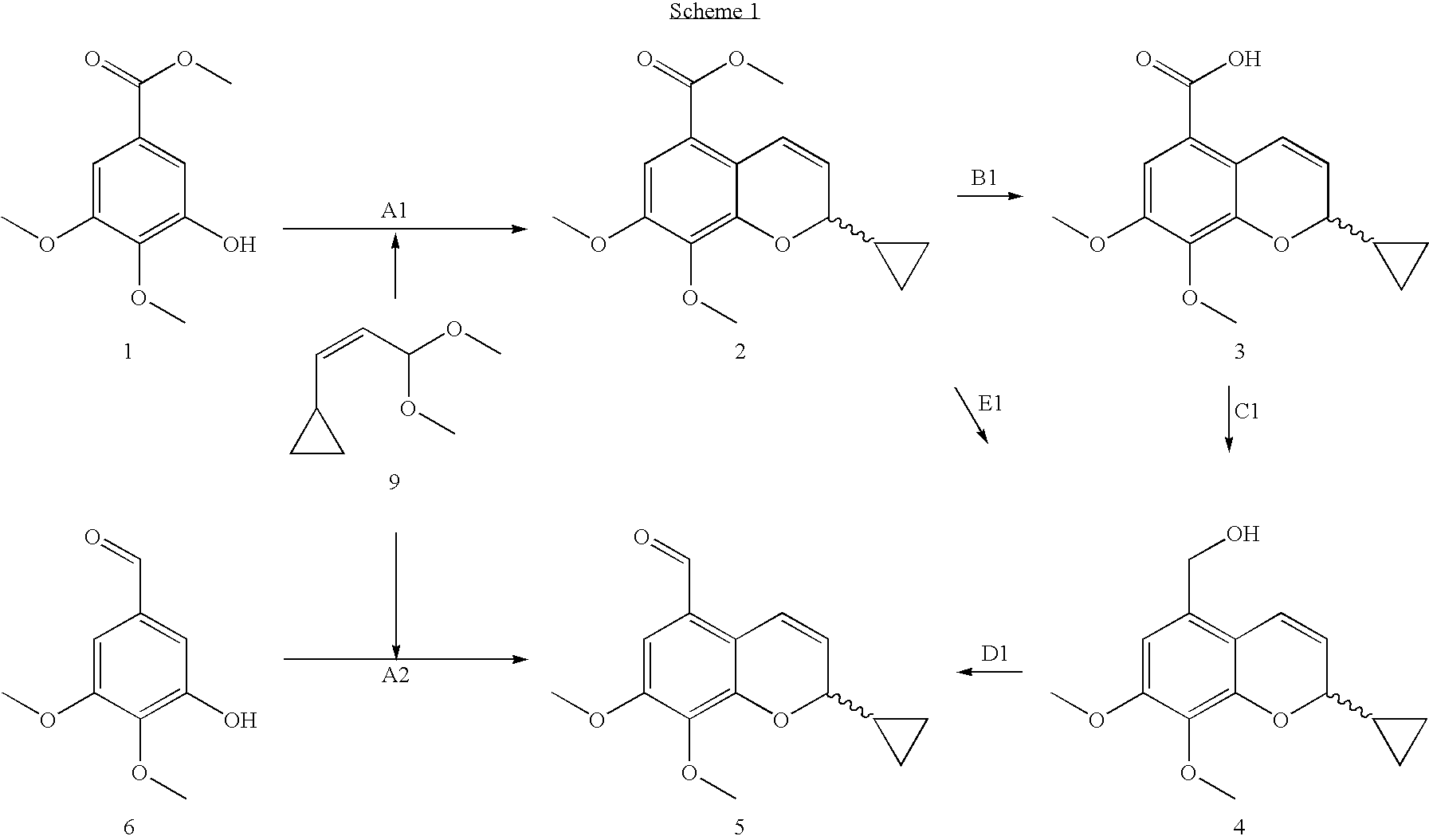Process for the preparation of 2H-chromenes
a technology of chromene and process, applied in the field of 2hchromene preparation, can solve the problems of low overall yield, short synthesis, and economic less attractiveness of synthesis as an industrial process
- Summary
- Abstract
- Description
- Claims
- Application Information
AI Technical Summary
Benefits of technology
Problems solved by technology
Method used
Image
Examples
example 1
[0030]This example illustrates the preparation of 2-cyclopropyl-7,8-dimethoxy-2H-chromene-5-carboxylic acid methyl ester 2 (step A1).
[0031]3-Hydroxy-4,5-dimethoxy-benzoic acid methyl ester 1 (20 g, 94 mmol) and cis-(3,3-dimethoxy-propenyl)-cyclopropane 9 (22.3 g, 90% pure, 141 mmol) were dissolved in 70 ml p-xylene and 3-picoline (3.6 ml, 37.6 mmol) were added. The mixture was heated up to reflux (oil-bath 160° C.) and the formed methanol was removed by a distillation head. A heated reflux condenser at 70° C. between reaction vessel and distillation head was used to specifically remove the formed methanol. After 24 hours the reaction mixture was worked up simply by distilling off the xylene and unreacted acetal. The dark oil was used directly in the next step.
[0032]Isolation of 2 is possible by crystallizing e.g. 2.6 g 2 from methylcyclohexane / TBME (3:1, 10 ml) after cooling (−20° C. 18 h). 1.07 g of pure 2 was isolated as a white-yellow solid.
[0033]1H-NMR (CDCl3) (ppm): 7.25 (dd, ...
example 2
[0034]This example illustrates the preparation of 2-cyclopropyl-7,8-dimethoxy-2H-chromene-5-carboxylic acid 3 (step B1).
[0035]Crude 2 (14.1 g, 60% content, 29.2 mmol) was dissolved in 135 ml of isopropanol / acetone (5:1) and 29 ml 4N NaOH solution was added. The reaction mixture was stirred 30 minutes at room temperature 1 h at 50° C. The solvents were then evaporated and the residue dissolved with 100 ml water and treated with charcoal to remove impurities and polymeric products. After filtration the aqueous layer was extracted with 2 times 100 ml TBME. Isopropyl acetate was added to the aqueous phase. The pH of the solution was adjusted to pH=1 with concentrated HCl. After separation, the aqueous phase was extracted with 2 times 100 ml of IPAc and the combined organic phase concentrated to dryness. The oil was crystallized from IPAc / heptane. Compound of formula 3 (7.8 g) was isolated as light brown crystals.
[0036]1H-NMR (CDCl3) (ppm): 7.44 (dd, 1H, J1=10.36 Hz, J2=1.52 Hz); 7.23 (...
example 3
[0037]This example illustrates the preparation of (2-cyclopropyl-7,8-dimethoxy-2H-chromen-5-yl)-methanol 4 (step C1).
[0038]To a solution of the acid 3 (7.8 g, 28.2 mmol) in dry THF (150 ml) LiAlH4 (0.85 g, 0.8 eq, 22.6 mmol) was added at 15° C. under Argon. Then the mixture was allowed to warm to RT and then stirred for 1 h at 50° C.
[0039]The quenching and work up was done adding 0.85 ml water and 0.85 g NaOH in 2.5 ml water. The precipitated aluminate salts were filtered and the organic phase was concentrated to dryness. Crude compound 4 was obtained as a light brown solid (usually in quantitative yield), which was further used as such.
[0040]A sample was crystallized from methylcyclohexane / TBME (1:1) providing material for the NMR:
[0041]1H-NMR (CDCl3) (ppm): 6.65 (d, 1H, J=10.1 Hz), 6.48 (s, 1H); 5.73 (dd, 1H, J1=10.1 Hz, J2=4 Hz); 4.64 (s, 2H); 4.2-4.26 (m, 1H); 3.88 (s, 3H, CH3); 3.84 (s, 3H, CH3); 1.73 (bs, 1H, OH); 1.21-1.31 (m, 1H, CH), 0.31-0.61 (m, 4H); mp.: 94-96° C.
PUM
| Property | Measurement | Unit |
|---|---|---|
| temperature | aaaaa | aaaaa |
| temperature | aaaaa | aaaaa |
| temperature | aaaaa | aaaaa |
Abstract
Description
Claims
Application Information
 Login to View More
Login to View More - R&D
- Intellectual Property
- Life Sciences
- Materials
- Tech Scout
- Unparalleled Data Quality
- Higher Quality Content
- 60% Fewer Hallucinations
Browse by: Latest US Patents, China's latest patents, Technical Efficacy Thesaurus, Application Domain, Technology Topic, Popular Technical Reports.
© 2025 PatSnap. All rights reserved.Legal|Privacy policy|Modern Slavery Act Transparency Statement|Sitemap|About US| Contact US: help@patsnap.com



